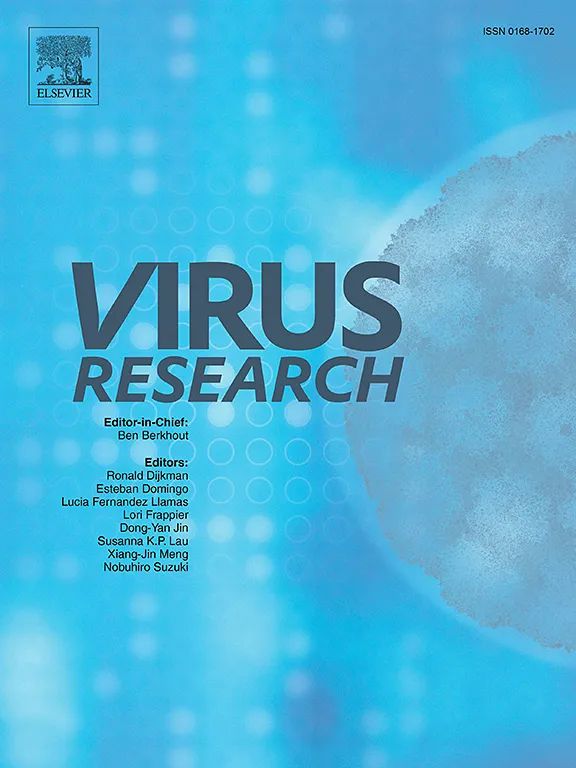Anti-influenza activity of Blumea Balsamifera (L.) DC. Extract: In vitro and in vivo evaluation against multiple influenza virus strains
IF 2.7
4区 医学
Q3 VIROLOGY
引用次数: 0
Abstract
Influenza virus epidemics occur annually, posing significant public health challenges. Although anti-influenza drugs are available, newly emerged viral strains frequently develop resistance, necessitating the discovery of new antiviral reagents. This study aims to evaluate the anti-influenza virus activity of Blumea Balsamifera (L.) DC. Extract (BBE) in both in vitro and in vivo settings. The antiviral activity of BBE was assessed using the CellTiter-Glo assay and the cytopathic effect (CPE) assay in Madin-Darby canine kidney (MDCK) cells, targeting influenza virus strains H1N1, H3N2, and four influenza B viruses. Specifically, BBE demonstrated significant inhibition of MDCK cell lesions caused by the A subtypes A/WSN/33 (H1N1) and A/Hong Kong/4801/2014 (H3N2), as well as the B subtypes B/Darwin/58/2019 (Yamagata), B/Phuket/3073/2013 (Yamagata), B/Sichuan Gaoxin/531/2018 (Victoria), and B/Brisbane/60/2008 (Victoria). The extract showed inhibitory concentration (IC50) values of 8.71, 11.38, 10.14, 4.66, 3.17, and 4.29 μg/mL, respectively. Time-of-drug-addition assay results indicated that BBE inhibits the early stages of influenza virus replication. Additionally, in vivo studies in murine models further confirmed the protective effects of BBE, where it reduced viral-induced weight loss, delayed mortality, and mitigated lung tissue damage. These findings suggest that Blumea Balsamifera (L.) DC. extract holds promise as a potential reagent against influenza viruses and warrants further investigation.
凤仙花的抗流感活性研究直流。提取物:体外和体内对多种流感病毒株的作用评价。
流感病毒每年都会流行,对公共卫生构成重大挑战。虽然抗流感药物是可用的,但新出现的病毒株经常产生耐药性,需要发现新的抗病毒试剂。本研究旨在评价香蓝花(Blumea Balsamifera, L.)的抗流感病毒活性。直流。提取物(BBE)在体外和体内的设置。采用细胞滴度- glo法和细胞病变效应(CPE)法在Madin-Darby犬肾(MDCK)细胞中评估BBE的抗病毒活性,以流感病毒株H1N1、H3N2和4种乙型流感病毒为靶点。具体而言,BBE对A亚型A/WSN/33 (H1N1)和A/Hong Kong/4801/2014 (H3N2)以及B亚型B/Darwin/58/2019 (Yamagata)、B/Phuket/3073/2013 (Yamagata)、B/Sichuan Gaoxin/531/2018 (Victoria)和B/Brisbane/60/2008 (Victoria)引起的MDCK细胞病变有显著抑制作用。抑菌浓度(IC50)分别为8.71、11.38、10.14、4.66、3.17、4.29 μg/mL。药物添加时间测定结果表明,BBE抑制流感病毒复制的早期阶段。此外,在小鼠模型中的体内研究进一步证实了BBE的保护作用,它减少了病毒引起的体重减轻,延迟了死亡率,减轻了肺组织损伤。这些研究结果表明,凤仙花(Blumea Balsamifera, L.)直流。提取物有望作为一种潜在的抗流感病毒试剂,值得进一步研究。
本文章由计算机程序翻译,如有差异,请以英文原文为准。
求助全文
约1分钟内获得全文
求助全文
来源期刊

Virus research
医学-病毒学
CiteScore
9.50
自引率
2.00%
发文量
239
审稿时长
43 days
期刊介绍:
Virus Research provides a means of fast publication for original papers on fundamental research in virology. Contributions on new developments concerning virus structure, replication, pathogenesis and evolution are encouraged. These include reports describing virus morphology, the function and antigenic analysis of virus structural components, virus genome structure and expression, analysis on virus replication processes, virus evolution in connection with antiviral interventions, effects of viruses on their host cells, particularly on the immune system, and the pathogenesis of virus infections, including oncogene activation and transduction.
 求助内容:
求助内容: 应助结果提醒方式:
应助结果提醒方式:


